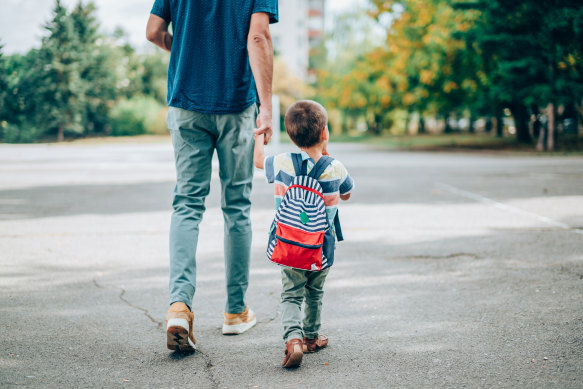- Perspective
- National
- Queensland
- Family
This was published 2 years ago
The simple change that could slash travel times during school terms
A dwindling number of children walk or cycle to school – relying instead on the taxi of mum and dad – and stranger danger is not to blame.
The solution to getting more children out of cars could include lower speed limits and closing streets to vehicles, according to a research project involving parents and children at two Queensland schools.

A study asked parents and children at Chancellor College Primary School and Secondary School on the Sunshine Coast about barriers to walking and riding to school.Credit: iStock
And given that school commutes in Brisbane make up one in four car trips during morning peak hour, getting more children to either walk or ride could reduce congestion.
With one in five Queensland children – and two out of three adults – overweight or obese, it could provide health benefits, too.
In Melbourne in 1970, more than half of all young people walked to school or higher education, compared with about one in five in 1994.
Is distance to the school gate to blame for this reduction? Not for everyone.
One study found 57 per cent of Australian parents reported the distance between home and school was three kilometres at most.
Another study found that at one Sydney school, 80 per cent of children lived within a one-kilometre radius of the school gate, but more than 62 per cent travelled there by car or bus.
To understand the trend, researchers including Ritwik Swain from the University of the Sunshine Coast surveyed children and parents at two schools in Queensland for their views on safety and infrastructure.
The study found a desire for better public transport, while many parents identified safety as a hurdle. The children, who walk slower, wanted more time to cross at the lights.
Families wanted better infrastructure, including separate, off-road bike paths and a well-connected footpath network.
“Bikeways on the road do not work for young children due to the risk that they will fall or swerve accidently onto the road,” one parent said.
Some parents requested a reduction in the speed limits around schools, which are typically 60km/h except during pick-up and drop-off, when they fall to 40km/h.
The paper referenced this study, which showed lowering speed limits to 32km/h in urban areas reduced the number of child deaths and injuries.
Stranger danger was not really a factor in the decision to drive to school, with just two comments from children and one from a parent.
So, what else could get families out of cars?
Maybe making streets around schools vehicle-free.
A handful of schools in Australia have joined the Open Streets program, which bans cars on streets near schools on select days during drop-off and pick-up, instead opening them up to walking, riding, scooting or skating.
In one such trial, at Moreland Primary School in Victoria, Bicycle Network reported that 50 per cent of survey respondents cycled more and 40 per cent walked more.
This mirrored the School Streets program in London, launched at hundreds of schools across the British capital since 2017 to reduce congestion, pollution and road danger. Paris has its own movement.
Anyone who commutes can verify that Brisbane’s roads get a lot quieter during school holidays.
Getting kids out of cars for their trip to school will reduce congestion – and maybe waistlines too.
Queensland Walks Month, held in August, could be the perfect time to start a new habit.
Coming soon: Get the inside word on the news, sport, food, people and places Brisbane is talking about. Sign up for our City Talk newsletter here.